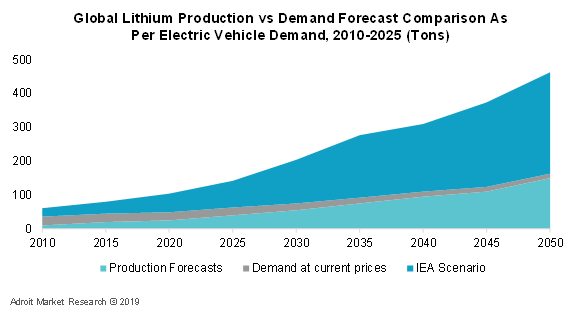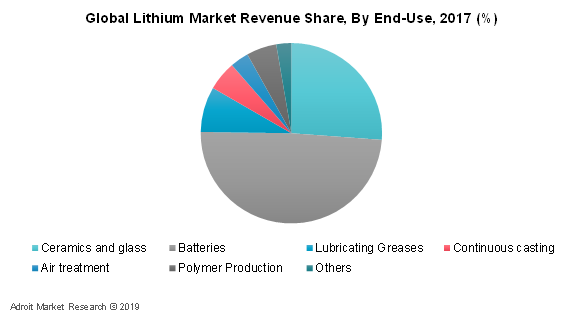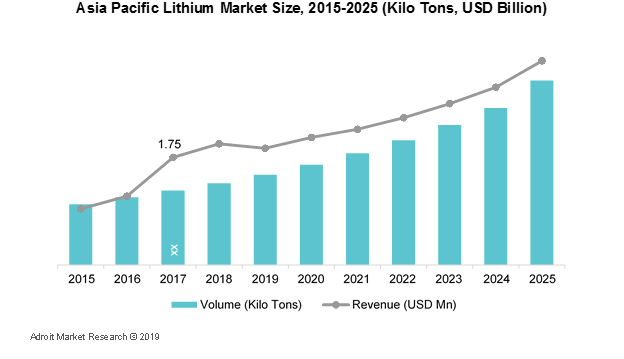The size of the global lithium market was estimated at USD 37.7 billion in 2022, and during the 2023–2030 forecast period, it is expected to grow at a CAGR of 22.1% from USD 22.1 billion in 2023 to USD 89.8 billion in 2030.
.jpg
)
Massive consumption of lithium and compounds in the production of Li-ion batteries and its use in the electric vehicle industry is set to boost the lithium demand during the forecasted years. Depletion of fossil fuel resources has resulted in the need to find an alternative energy source.
Propagation of the EVs, globally, has ultimately reduced the use of fuel-burning vehicles which has significantly reduce the greenhouse gas emissions and perpetuated the green energy economy. The automotive industry is on the verge of an electric revolution. Factors such as the efficiency and environmental cleanliness of lithium technology have earned it immense worldwide political and financial support for its development. Further, this has greatly interested leading automobile manufacturers to shift their design and production from conventional gasoline cars to electric vehicles. Mass production of EVs based on other factors such as charging infrastructure, legislation, fuel cost, and tax incentives has extensively driven the global lithium market. The International Energy Agency has stated that the number of on-road electric vehicles is likely to hit 13 million by the end of 2020 and rise up to 220 million by the end of 2030. It is anticipated that the future lithium resources will be majorly governed by the battery industry, followed by grid electrical storage as well as its upcoming applications in the nuclear power industry.
Since 2017, the price of lithium, the key raw material of the Li-ion battery, has risen dramatically since the demand for the raw material has outstripped its supply. Increasing complexities and rapidly changing market dynamics have widely impacted and revolutionized the automotive OEMs, battery manufacturers, refining and mining companies as well as the financial investors who were previously willing to invest in this market.
Key company profile in the Global Lithium Market report are Albemarle Corp.; Ganfeng Lithium Co., Ltd.; SQM S.A.; Tianqi Lithium Corp.; Livent Corp.; Lithium Americas Corp.; Pilbara Minerals; Orocobre Ltd. Pty. Ltd.; Mineral Resources, BYD Company, LG Chem, Contemporary Amperex Technology Co. Ltd. (CATL), Panasonic Corporation, Samsung SDI, BAK Group, Hitachi, Clarios, GS Yuasa Corporation (GS Yuasa), and Toshiba Corporation
Lithium Market Scope
| Metrics | Details |
| Base Year | 2023 |
| Historic Data | 2018-2022 |
| Forecast Period | 2024-2030 |
| Study Period | 2018-2030 |
| Forecast Unit | Value (USD) |
| Revenue forecast in 2030 | USD 89.8 billion |
| Growth Rate | CAGR of 22.1% during 2023-2030 |
| Segment Covered | By Type, Regions |
| Regions Covered | North America, Europe, Asia Pacific, South America, Middle East and Africa |
| Key Players Profiled | Albemarle Corporation (US), FMC Corporation (US), SQM SA (Chile), Tianqi Lithium (Australia), Ganfeng Lithium Co., Ltd. (China), General Lithium (Haimen) Corporation (China), and ZHONGHE Co., Ltd (China) |
Key segments of the Lithium Market
by Product, (USD Billion)
• Carbonates
• Hydroxide
• Others
by applications,(USD Billion)
• Automotive
• Consumer Electronics
• Grid Storage
• Glass & Ceramics
• Others
Type,USD Billion)
• Lithium Carbonate
• Lithium Hydroxide
• Mineral Concentrates
End-Use (USD Billion
• Ceramics and Glass
• Batteries
• Lubricating Greases
• Continuous Casting
• Air treatment
• Polymer Production
Region Overview, (USD Billion)
• North America
o United States of America
o Canada
o Mexico
• Europe
o France
o Germany
o Italy
o the Netherlands
o Poland
o Russia
o The United Kingdom
o Rest of Europe
• Asia-Pacific
o China
o India
o Indonesia
o South Korea
o Rest of Asia-Pacific
• South America
o Argentina
o Brazil
o Peru
o Uruguay
o Rest of South America
Frequently Asked Questions (FAQ) :
Lithium cost breakdown reflects that lithium materials make up around 10 to 20% of overall battery production costs. The rapidly surging price of lithium is expected to increase battery production costs by 10%. Powering demand for lithium batteries for use in different industries has doubled the price of lithium from 2016 to 2018. Meanwhile, the price of cobalt (other key raw material used in battery cathodes) has multiplied three times since January 2016 and has made these metals enter into the spotlight. It is analyzed that the global lithium production rose by 13% from 2016 to 2017, i.e., 43,000 tons to 49,000 tons.
Supply-Demand Scenario
As per the French Environment and Energy Management, lithium-ion batteries account for the largest share in the future development of the electromobility, however, its declining supply of lithium is expected to become an issue by 2020. Presence of a limited number of players in the lithium industry and their oligopolistic nature, geopolitical criticality of resources and need to explore untapped and potential economies are the key issues being faced by the industry and act as a challenge to the lithium supply. Among the top 10 lithium producers in the world, US-based FMC, Albemarle and Chile’s SQM are the three big lithium extractors in the sector accounting for a market share of more than 50% along with the other Chinese companies such as Tianqi and Ganfeng. Also, in 2016, Chile, Argentina, Australia, held approximately 80% of the global lithium production, with Australia being the major.
 However, to cater to rising demand from industries, lithium players are expected to expand existing mines and look for the new mining locations. Also, when electric vehicle demand uptake hits its inflection point, demand is expected to highly appreciate and motivate industrialists for more supply. Additionally, government approvals such as those in Chile for mine expansions would “open the floodgates” for the lithium products. Furthermore, vulnerabilities could emerge on account of increasing competition among lithium end-use industries. China, one of the biggest lithium producers has placed a policy of security of supply, to favor its internal market by supplying the entire lithium to its domestic EV industry.
However, to cater to rising demand from industries, lithium players are expected to expand existing mines and look for the new mining locations. Also, when electric vehicle demand uptake hits its inflection point, demand is expected to highly appreciate and motivate industrialists for more supply. Additionally, government approvals such as those in Chile for mine expansions would “open the floodgates” for the lithium products. Furthermore, vulnerabilities could emerge on account of increasing competition among lithium end-use industries. China, one of the biggest lithium producers has placed a policy of security of supply, to favor its internal market by supplying the entire lithium to its domestic EV industry.
Commercially, lithium is widely used in the form of lithium carbonate on account of its application in a myriad of applications such as batteries, ceramics, glass, and others. Lithium metal, in higher volumes, is also consumed as the mineral concentrates, since it finds a number of applications in the production of glass, ceramics, and metal castings. Lithium carbonate accounted for nearly 60% of the market revenue in 2017. However, lithium is losing market share to lithium hydroxide, on account of its superior performance and increasing applications when compared to the lithium carbonate applications. Industry leaders such as Nemaska Lithium are presently venturing into lithium hydroxide as their main business on the back of its growing use among automotive sector. With the availability of lithium hydroxide being tighter than lithium carbonate, battery producers are competing with other end users over the selection of the ideal raw material.
Hygroscopic properties of lithium bromide and lithium chloride makes it suitable to be used as a desiccant for gas streams. Lithium bromide solutions are also deployed in the air conditioning systems of large buildings. Apart from its use for manufacturing glass & ceramics, lithium is being utilized in metallurgical industries as a flux to help reduce the energy costs, which in turn, is expected to further drive the global lithium market growth. Lithium enhances the fusing of metals at the time of soldering or welding. In applications of continuous steel casting, lithium lowers the viscosity, improves flow rates and assists in thermal insulation. Aforementioned factors are poised to drive the demand the lithium market size in the near future.

With an insatiable demand for energy and the need for mobility continues at a furious pace, the demand for lithium is also expected to buckle up by the end of this decade. Lithium is being witnessed as the key component in green energy storage technologies and is rapidly becoming a metallic commodity of crucial importance. Increasing awareness and the detrimental impacts of the conventional fuel-powered vehicles on the environment has encouraged automotive industries to explore sustainable sources of power for vehicles. This led to the introduction of the hybrid vehicles which run on combustion engines, requiring gasoline or diesel in combination with a battery-powered electric motor. Rising inclination towards a pollution free electric future has provided a robust boost to the global lithium market.
Falling prices of Li-ion batteries for EVs, uncertainty over the most suitable raw material, race among battery pack manufacturers and automobile companies to secure minerals necessary for battery manufacturing has primarily shaped the EV industry over the past few years. Also, manufacturers and suppliers such as automobile companies, investors, lenders, and battery pack companies are constantly eying the changes and lack of uncertainty in the downstream market due to disruptions in the upstream market (mining companies and lenders).
European government has recently placed certain directives to encourage the spread of electric vehicles. Some of them being the Clean Vehicle Directive 2009/33/EC and the Energy Efficiency Directive 2006/32/EC. Also, European lithium market and rapid adoption of EV’s is driven by the various government initiatives and lucrative incentive schemes such as the free road tax coupled with free charging infrastructures and stations.
 Asia Pacific dominated the global lithium market in 2017 and held a market revenue of USD 1.75 billion. China is the largest lithium consumer with the presence of largest battery manufacturers and accounting for nearly 60% of the battery market. In order to sustain battery production, Chinese players are now hunting for the potential lithium sources outside the nation's boundary. In September 2017, one of the leading Chinese car manufacturer Great Wall Motor bought 3.5% stake of Australian lithium miner, Pilbara Minerals. As per this strategy, Great Wall will acquire 75,000 tons of battery-grade lithium carbonate per year for the next five years. With the aforementioned strategies, China is expected to suffice its growing lithium demand and maintain the long term market sustainability by partnering with battery manufacturers to stabilize lithium demand and supply.
Asia Pacific dominated the global lithium market in 2017 and held a market revenue of USD 1.75 billion. China is the largest lithium consumer with the presence of largest battery manufacturers and accounting for nearly 60% of the battery market. In order to sustain battery production, Chinese players are now hunting for the potential lithium sources outside the nation's boundary. In September 2017, one of the leading Chinese car manufacturer Great Wall Motor bought 3.5% stake of Australian lithium miner, Pilbara Minerals. As per this strategy, Great Wall will acquire 75,000 tons of battery-grade lithium carbonate per year for the next five years. With the aforementioned strategies, China is expected to suffice its growing lithium demand and maintain the long term market sustainability by partnering with battery manufacturers to stabilize lithium demand and supply.

